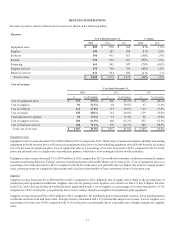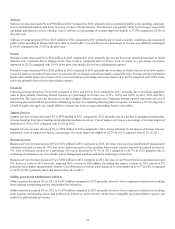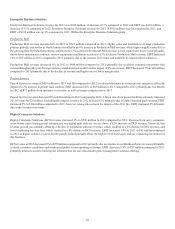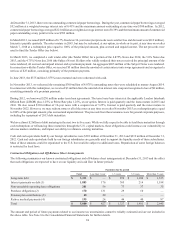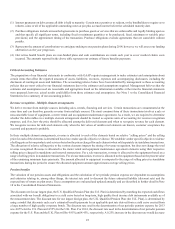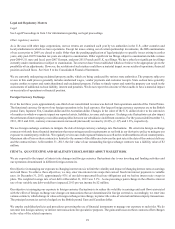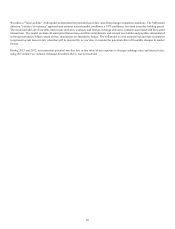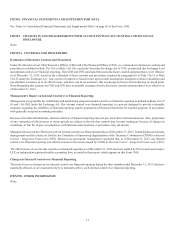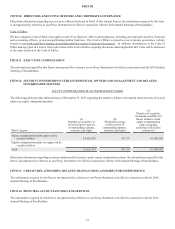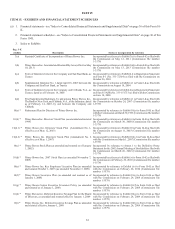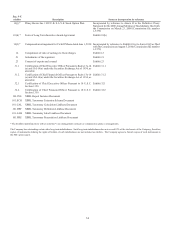Pitney Bowes 2013 Annual Report Download - page 35
Download and view the complete annual report
Please find page 35 of the 2013 Pitney Bowes annual report below. You can navigate through the pages in the report by either clicking on the pages listed below, or by using the keyword search tool below to find specific information within the annual report.
24
At December 31, 2013, there were no outstanding commercial paper borrowings. During the year, commercial paper borrowings averaged
$52 million at a weighted-average interest rate of 0.41% and the maximum amount outstanding at any time was $300 million. In 2012,
commercial paper borrowings averaged $221 million at a weighted-average interest rate of 0.39% and the maximum amount of commercial
paper outstanding at any point in time was $709 million.
In March 2013, we issued $425 million of 6.7% fixed-rate 30-year notes (net proceeds received after fees and discount were $412 million).
Interest is payable quarterly. The notes mature in 2043, but may be redeemed, at our option, in whole or in part, at any time on or after
March 7, 2018 at a redemption price equal to 100% of the principal amount, plus accrued and unpaid interest. The net proceeds were
used to fund the Tender Offer (see below).
In March 2013, we completed a cash tender offer (the Tender Offer) for a portion of the 4.875% Notes due 2014, the 5.0% Notes due
2015, and the 4.75% Notes due 2016 (the Subject Notes). Holders who validly tendered their notes received the principal amount of the
notes tendered, all accrued and unpaid interest and a premium payment. An aggregate $405 million of the Subject Notes were tendered.
In connection with this Tender Offer, we received $5 million from the unwind of certain interest rate swap agreements and recognized a
net loss of $25 million, consisting primarily of the premium payment.
In June 2013, the $375 million 3.875% notes matured and were redeemed with cash.
In November 2013, we redeemed the remaining $300 million of 4.875% outstanding notes that were scheduled to mature August 2014.
In connection with this redemption, we received $3 million from the unwind of an interest rate swap and recognized a loss of $8 million,
consisting primarily of a premium payment.
During 2012, we borrowed $230 million under term loan agreements. The term loans bear interest at the applicable London Interbank
Offered Rate (LIBOR) plus 2.25% or Prime Rate plus 1.25%, at our option. Interest is paid quarterly and the loans mature in 2015 and
2016. We also issued $110 million of 10-year notes with a coupon rate of 5.25%. Interest is paid quarterly and the notes mature in
November 2022. However, we may redeem some or all of the notes at any time on or after November 2015 at a redemption price equal
to 100% of the principal amount, plus accrued and unpaid interest. The proceeds from these issuances were for general corporate purposes,
including the repayment of 2013 debt maturities.
We have almost $2 billion of debt maturing in the next two to five years. While we fully expect to be able to fund these maturities through
cash redemptions or refinancing these maturities through the U.S. capital markets, these obligations could increase our vulnerability to
adverse market conditions, and impact our ability to refinance existing maturities.
Cash and cash equivalents held by our foreign subsidiaries were $392 million at December 31, 2013 and $219 million at December 31,
2012. Cash and cash equivalents held by our foreign subsidiaries are generally used to support the liquidity needs of these subsidiaries.
Most of these amounts could be repatriated to the U.S. but would be subject to additional taxes. Repatriation of some foreign balances
is restricted by local laws.
Contractual Obligations and Off-Balance Sheet Arrangements
The following summarizes our known contractual obligations and off-balance sheet arrangements at December 31, 2013 and the effect
that such obligations are expected to have on our liquidity and cash flow in future periods:
Payments due by period
Total Less than 1 year 1-3 years 3-5 years More than 5 years
Long-term debt $ 3,311 $ — $ 876 $ 1,100 $ 1,335
Interest payments on debt (1) 1,883 176 305 214 1,188
Non-cancelable operating lease obligations 201 56 73 37 35
Purchase obligations (2) 170 131 29 10 —
Pension plan contributions (3) 40 40—— —
Retiree medical payments (4) 195 24 44 40 87
Total $ 5,800 $ 427 $ 1,327 $ 1,401 $ 2,645
The amount and period of future payments related to our income tax uncertainties cannot be reliably estimated and are not included in
the above table. See Note 8 to the Consolidated Financial Statements for further details.





